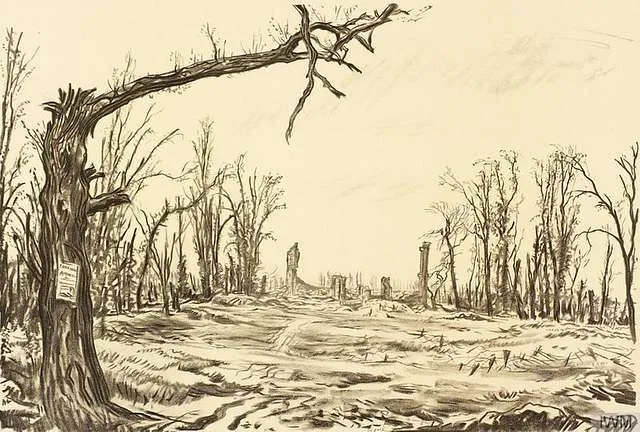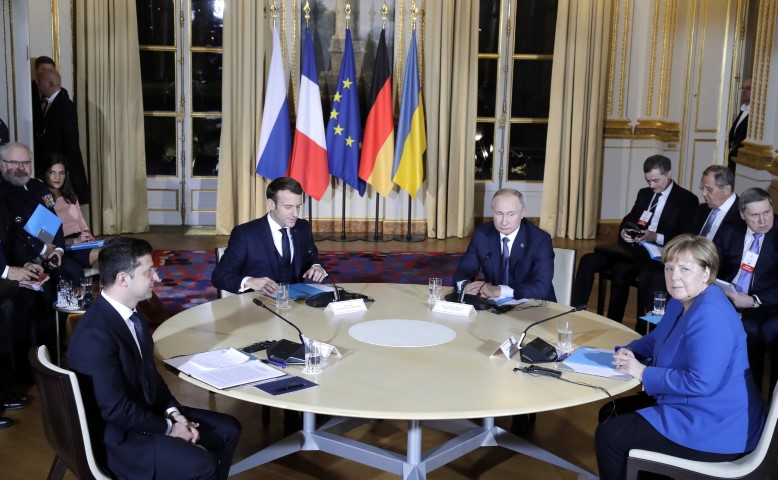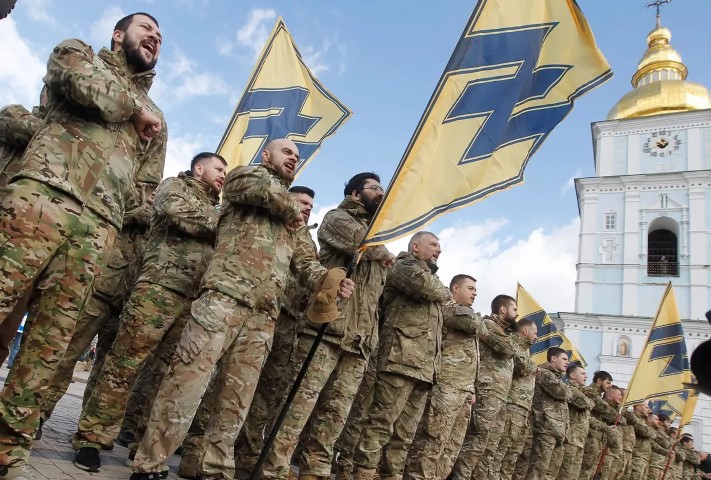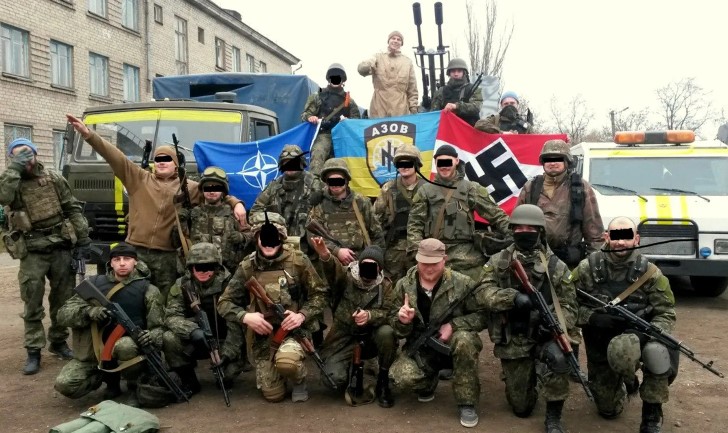

→ other articles

reasons to end nukes
Did you know... Zelensky was elected in 2019 because he promised to make Peace with Russia, regarding the eastern Ukrainian civil war in the Donbas (which began in 2014). But as things turned out, that Donbas war continued on and has caused this massive war with Russia... all because Zelensky's peace promise got nixed by the far-right ethnic-nationalist parties.
Zelensky campaigned on a promise to End the War in eastern Ukraine – between the Ukrainian ethnic-nationalist military and the Donbas breakaway regions (that were backed by Russia).
… And since Zelensky campaigned as a peacemaking candidate, with a promise to negotiate a peace agreement with Russia in order to end the five year armed conflict in eastern Ukraine (over the freedom of the Donbas breakaway Republics), and since he won the election with a landslide victory, this evidently shows that the majority of Ukrainians in 2019 did in fact want peace with Russia rather than continue to fight over these eastern territories and Crimea. So, why did this promise not get fulfilled, and why did Zelensky turn from a 'I promise peace with Russia' president into a 'we refuse to negotiate' president?
→
According to the
Kyiv Post in 2019, “Zelensky was able to secure his 2019 presidential victory by promising Ukrainians to Stop the Donbas War, defeat corruption and revive the country’s economy.” He promised to “stop the shooting in Donbas” and negotiate an end to the war in Ukraine’s Donbas regions. Then, after being elected on his campaign promises of 'no-more-fighting and no-more-corruption', Zelensky said in his first speech as President of Ukraine, “Our first task is to end fire in the Donbas, and we're ready for a dialogue.” Later he also tells the press that he would make troop withdrawal from the Donbas conflict-zones “a priority.”
So, Zelensky won his presidential election in 2019 with the campaign promise “to stop the shooting in the Donbas" and a promise to "make peace with Russia" in regards to the eastern Donbas and the Crimea Peninsula, and he also proposed that Ukraine would 'not join Nato' – in order to appease Russia's concerns about their national security if Ukraine were to allow Nato nuclear weapons placed on their border with Russia. Zelensky campaigned on these peace promises, and he won the presidential election by a landslide against the sitting president who had continuously refused to end the long and bloody war by signing a peace agreement with the Donbas breakaway-republics and with Russia (who was helping them).
The main reason that Zelensky received landslide votes was because the Russian-related residents of the eastern and southeastern Ukrainian regions voted for Zelensky, since he was campaigning as a peacemaker with Russia and someone who respected the Russian-related and Russian-speaking residents; rather than a Russian-hater as was the sitting president at that time. Before this time in 2019, and ever since the overthrow of the Donbas-born president and his Donbas Party of Regions, the eastern Donbas residents had been subject to new laws enacted by the ultra-nationalist Ukrainian parties, which outlawed Russian-speaking schools and TV stations throughout Ukraine, and they also had been subject to Ukrainian military and Azov-nazi attacks in the residential areas of the Donbas breakaway republics (which had refused to follow the new ultra-nationalist laws).
SO, the Donbas regions gave all of their voter support to Zelensky — their only hope for peace and ethnic civil rights in their regions. This was their best hope, because their own Donbas 'Party of Regions' had been forcibly banned and outlawed by the new government that had forcibly overthrown that party and its president in the 2014 "revolution" – which was financially and media backed by the US and EU.
Below is a map of the 2010 election-results, showing overwhelming support in the eastern and southeastern regions for the Russian-friendly and Donbas-born president, Victor Yanukovich, who was later overthrown in the 2014 'revolution' by pro-Western and pro-EU political opponents and militantly fueled by the neonazi ethnic-nationalist parties.
Yanukovich was overthrown after he did not sign the proposed 'European Union Association Agreement' — which was an agreement that the EU would open more EU trade, loans and investments with Ukraine in exchange for Ukraine abandoning their trade agreements with Russia and also agreeing to the EU's proposed austerity measures such as cutting social programs, wages and retirement pensions. Yanukovich had been negotiating with the EU for more favorable terms in the agreement, such as less austerity measures and retaining Ukraine's current trade agreements with Russia. He argued to the EU and to the Ukrainian parliament that abandoning Ukraine's trade agreements with Russia would be disastrous for the eastern regions and that the EU's austerity measures would be too painful and unacceptable for most Ukrainian people. Yet the EU refused to compromise on its terms, and after Yanukovich did not sign-on to the EU terms in late 2013, he was vilified by the Western EU-backed news stations and EU-backed social media channels.
Note that the darkest blue means over 75% of the voters
and the lighter blue means over 50% of the voters.
In major cities of the dark-blue areas, Yanukovich received over 85% of the votes.

But getting back to the topic of Zelensky's election —
after he was elected, Zelensky proceeded to set up peace talks with Russia. He agreed to a ceasefire in the Donbas of eastern Ukraine, and also agreed to peacefully accept the two Russian-friendly breakaway republics in eastern Ukraine – agreeing that their borders be the same as was previously agreed in 2015 Minsk II agreements, and that Ukraine would agree to not instigate any military attacks on annexed Crimea (now governed by Russia).
President Zelensky pursued this peace meeting with Putin, in the face of staunch criticism from political opponents. Zelensky said, “Some say that it’s impossible to have a dialogue with Putin”, but without a dialogue we’re like on a treadmill [going nowhere]." Zelensky then had several phone talks with Putin, before meeting in person in December 2019 in Paris, along with the German chancellor and French president.

Vladimir Putin, Emmanuel Macron, Angela Merkel, and Vladimir Zelensky hold peace talks at the 'Normandy Summit' in Paris.
Issues to negotiate in this 2019 meeting included: an extended cease-fire, a major prisoner swap, control over the separatist area's border with Russia, talks on extending Ukraine’s gas supply contracts with Russia, free elections in the separatist-controlled regions, and a 'special status law' for Donetsk and Luhansk territories - in which the areas remain part of Ukraine, and are able to vote in national elections, yet have special 'limited-autonomy' in their regional government.
To proceed further with the peace meetings, Putin insisted that Ukraine sign on to the "Steinmeier formula", which would allow Europe-monitored elections to take place in the separatist-areas of Donetsk and Luhansk providences (the self-proclaimed regional-autonomous Republics of the Donbas).
This issue of free elections in those separatist areas goes back to the Minsk II peace agreements signed in 2015, which granted a wider autonomy and local elections for the separatist regions, as well as the withdrawal of heavy weapons in the Donbas. Minsk II stated that the separatist-territories could have their own free elections uncontrolled by the Kyiv government, yet monitored by the European Organization for Security and Cooperation, and that these free elections must come before any withdrawal of Russian troops placed in the those areas to help defend against Ukraine's military and Azov militia attacks and bombings.
Thus, Zelensky set out to revive the 2015 Minsk agreements in his meetings with the leaders of Germany, France, and Russia, in order to negotiate an end to the war in the Donbas (the regions of eastern Ukraine), and to agree that the two breakaway republics of Luhansk and Donetsk would be allowed more self-autonomous governance, after holding European-monitored elections.
Zelensky even promised eastern Ukrainians in the Donbas that “he would create a Russian-language TV channel” – because ever since the 2014 overthrow of the Russian-friendly president (born in the Donbas), the new pro-western and pro-nationalistic Kyiv government had made it illegal for TV stations to speak in Russian... even though the majority of the eastern and southeastern Ukrainian residents were primarily Russian-speaking.
But Zelensky’s decision to agree to Europe-monitored elections in the separatist-controlled areas was met with immediate protests in Kyiv and other cities by Ukrainian ethnic-nationalist groups - who are against those breakaway areas having their own Europe-monitored elections to determine their local government, as the nationalist parties insist that any elections in those areas must be monitored only by Ukraine government and 'security forces'. The far-right nationalists also did not want the Russian-speakers in those areas to vote in national elections.
Read – csis.org/analysis/zelensky-and-putin-paris-what-success
Earlier before these meetings, in May 2019, Zelensky asked Ivan Aparshyn, a long-time security analyst and former the head of the Security and Defense Expertise Department, to be his Defense Advisor and to help develop a new national security strategy to include cooperative peaceful relations with Russia and the breakaway republics. In an interview with the Ukraine press, Aparshyn says that in order to end the war in the Donbas, there needs to be a decision made between the two basic options –
either to seek a military win OR seek a negotiated peace settlement.
….But as Aparshyn points out, the military option will include further “human cost” which he believes is “not be worth it.” He said, “I would never suggest that someone use the help of the operation of the Armed Forces of Ukraine to decide on the return of the territory of Donbas and Crimea. Never.”
hromadske.ua/en/posts/zelenskyys-defense-advisor
So then in October 2019, Zelensky began to implement his promise of Peace in the Donbas. In agreements with Russia and the breakaway republics, he begins a plan of ceasefire in the conflict zones and negotiations with Russia to make a lasting peace agreement.
According to RadioFreeEurope.org October 29 2019, “Ukrainian President Volodymyr Zelenskiy, who rose to the presidency earlier this year on promises to end the conflict, accepted a withdrawal plan as part of the the Steinmeier Formula.” “The president is keen on fulfilling his promise to stop the war.” To resolve the conflict, the president intends “to revive the Normandy Format” in his meetings between the leaders of Germany, France, Ukraine, and Russia, and he intends to use the Steinmeier Formula, under which the Russian-occupied regions would receive more self-governance after free and fair elections are held according to Ukrainian law.” The “Steinmeier formula” was proposed in 2016 by the then German foreign minister Frank-Walter Steinmeier. His idea envisaged the sequencing of local elections in the separatist-held Donbas which, if deemed acceptable by the Organisation for Security and Co-operation in Europe, “would clear the way towards a permanent special status of the fought-over territories involving the breakaway republics of Donetsk and Luhansk.”
Next, Zelensky called for a Ceasefire in the Donbas war zones, and most of the Ukrainian military soon began to withdraw from the war zones, as well as the Russian-backed separatist militias.
…. On October 29 2019 in a press statement by Martin Sajdik, the special representative of the Organization for Security and Cooperation in Europe (OSCE), “Kyiv and Russia-backed separatists have begun withdrawing troops and weapons from a front-line area in eastern Ukraine, as part of a plan to end the Donbas region's five-year conflict. Thus, the sides, literally by stepping backwards, have today made a big step forward,” and he added that OSCE monitors were on the ground to check compliance by both sides. The Ukrainian Foreign Minister Vadym Prystayko said "We are beginning [the process of withdrawal] today." And Rodion Miroshnik, a separatist official in the Luhansk region, stated that the separatists' side was now pulling out from the conflict zone.
However, the far-right nationalist militias, notably the Azov Battalion fighters of the major neonazi political party, refused to abide by the ceasefire, and when Zelensky made a special effort to travel to their battalion, to remind them that he was the president and had ordered them to withdraw, they refused and also threatened his life and an overthrow of his government if Zelensky went any further with the peace deal. As was seen on recorded video by the national news media, when Zelensky arrived in the Donbas conflict zone controlled by the far-right militias, he was confronted by the neonazi Azov Battalion which loudly refused the president's orders to withdraw and even threatened the president, and on video the president is seen to be evidently surprised and shaken up.

In addition to their refusal to withdraw from the fighting, the far-right nationalist parties immediately launched a national campaign called “No to Capitulation” to sabotage the president's plans for peace, and they quickly organized a large night protest in the capital that very night on October 29, carrying torches and weapons, chanting "No surrender," and demanding that the government stop any negotiations with the separatists and Russia, in order to create peace in eastern Ukraine. The leader of the far-right Democratic Ax even threatened Zelensky with an outright coup if the Ukrainian government tries to sign any peace negotiation with the eastern separatists and Russia. Later, Zelensky accused the Democratic Ax of planning the armed protest as part of a coup plot. But no serious crackdown on the Democratic Ax followed. However, Zelensky was obviously shaken up by all of this.
From a November 11 2019 article in 'The Conversation' – “Andriy Biletsky, the proudly fascist Azov Battalion leader who once pledged to 'lead the white races of the world in a final crusade…against Semite-led Untermenschen', vowed to bring thousands of fighters to Zolote, if Zelensky pressed any further. Meanwhile, a parliamentarian from the party of former Ukrainian President Petro Poroshenko publicly hinted that Zelensky might be blown to bits by a militant’s grenade.”
And the New York Times writes, “nationalist opposition [in Ukraine] complicates any diplomatic agreement.... Zelensky would be taking extreme political risks even to entertain a peace deal" as his government "could be overthrown by far-right groups, if he agrees to a peace deal."
– From this time on... Zelensky abandoned his election promise to make a peace agreement with Russia for 'Peace in the Donbas.'
The extremist ideology of the Ukrainian 'nationalists' started to be pushed into the mainstream media. And Zelensky started to talk about how the Russian related people of eastern Ukraine ought to leave, unless they are willing to follow the nationalistic aims of abolishing Russian-speaking in news, media and in schools. Zelensky said on TV that “for the sake of your children and grandchildren,” those who identify as Russian in Donbas should “go find a place for yourself in the Russian Federation.” This was, effectively, a call for the ethnic cleansing of ethnic-Russians in Donbas.
– Brics News August 30, 2021:
Far-Right ideology has cemented itself in Ukraine under Zelensky
Thus, we can reasonably infer that, even though the vast majority of voters wanted to settle on a peace agreement with Russia, ...the radical-right Russian-hating Ukrainian nationalists gained control of Ukrainian politics and did not allow any peace agreements, even though the neonazi nationalist parties received only about 5% of votes in the recent elections. Democracy?
And, the neonazi pro-violence nationalists, who were opposed to peace, were encouraged and partly funded by the covert US CIA -- because any military struggles or war with Russia were considered to be beneficial to US interests and geopolitical plans.
So, this is why Zelensky suddenly transformed... from seeking a peace agreement with Russia .. to refusing to make a peace deal.... because of pressure from the far-right neonazis and pressure from the US. And still, the US is preferring War over Peace. And because the US has goaded Ukraine to not make a peace agreement, the situation is Far Worse than when the war began and when they could have made peace. (when Putin kept offering easy peace deals)..
Stepan Bandera and the Ukrainian neonazis
Did you know that Stepan Bandera is considered a National Hero in Kyiv and in western Ukraine. He was a Ukrainian ultra-nationalist and antisemite whose followers engaged in a campaign of ethnic cleansing against Jews and Poles during World War II.
Bandera’s followers in the far-right Organization of Ukrainian Nationalists (OUN) and its paramilitary wing, the Ukrainian Insurgent Army (UPA), engaged in a campaign of ethnic cleansing, killing tens of thousands of Poles and Jews. The most vicious events were those of the Volhynia Massarce and the killings in Eastern Galicia, which took place in 1943-1944.
Ukraine's Military commander Valerii Zaluzhnyi took a selfie with a portrait of Stepan Bandera, and the Verkhovna Rada tweeted a reference to Stepan Bandera and the Ukrainian Church celebrated the 114th anniversary of the birth of Stepan Bandera.
And just recently in early January, the Zelensky government and army celebrated Bandera's birthday.
The Azov Militia
Did you know that, before the 2022 war started in Ukraine, the Azov Militia was widely condemned by the media and by human rights organizations, for being a militant wing of neonazi groups in Ukraine, and also condemned for their brutality and terror campaign against ethnic-Russians and other Russia-friendly residents in the Donbas cities of eastern Ukraine.
But then.... the US State Dept. and western media led a campaign to 'rebrand' the Azov as “freedom fighters” – while accusing any critics of the Azov as pro-Russian talking points. The New York Times even referred to the Azov as the “celebrated Azov Battalion.” So, the previously condemned Azov were quickly and conveniently 'rebranded' as “freedom fighters” soon after the Russian invasion.
Ever since 2014, the ultra-nationalist ethnic-Ukrainian Azov fighters were frontline in their war against the newly-formed breakaway republics in eastern Ukraine, which Russia began to support after the Ukraine army and nationalist militias (such as the Azov) started attacking and terrorizing the breakaway republics in 2014.
So at the start of the war with Russia, most of the Azov Militia were in and around the southeastern port city of Mariupol, making sure that the key port city would not become part of the breakaway Donetsk republic (which in 2014 had voted to be independent from the pro-EU Kyiv government that had the overthrown the Donbas-born president).
As western media showed in their news, the Azov were defending the city of Mariupol, though they were eventually were defeated and captured by Russian forces. And no doubt their military stand showed brave courage. But the media completely ignored Azov’s reported atrocities in Mariupol, where locals accused the group of using civilians as human shields and executing those who attempted to flee, and one video showed Azov fighters proudly declaring Stepan Bandera, the Nazi collaborator and mass murderer of Jews and Poles, to be their “father.”

Ukrainian “Democracy” ??
We are all reminded by the government and news media that …. “This war is a 'Battle for Democracy'” ...as Democracy is being threatened by the evil Authoritarian and Autocratic Putin.
So... How “democratic” is the Ukraine government?
The Zelensky-led nationalist government has banned all 11 opposition parties, including the second most popular political party in Ukraine in the 2019 general election. All of these banned parties were previously described by the U.S. as “democratic.” So Zelensky's party and the neonazi parties are now the only publically accepted parties in Ukraine, and it is not permitted to publically voice any opinion or any argument against the government's policies or laws. Ukrainian Democracy?
Ukraine-bans-political-opposition
The Ukrainian government has closed down all critical media. Over the past two years, half of the television channels in Ukraine have been accused of pro-Russia sympathies and have been removed. Since February 2022, all remaining media are obliged to relay only the point of view of the Office of the President, under threat of being accused of treason.
During this year, all people, groups, and opposition parties with differences of opinion, or government criticism, have been media banned. Opposition leaders have been rounded up and have disappeared into prisons run by neo-nazi interrogation teams, and their property has been seized.
In March, the Ukrainian government declared martial law and a sedition law which permits the government police to imprison anyone “suspicious” of not being loyal to the Ukrainian government. It established life imprisonment with property confiscation as the maximum penalty for individuals found guilty of treason. So far under this law, there have been numerous mayors and other elected officials jailed for treason because they surrendered to the Russian army or because they were accused of being Russian sympathetic.
Under the law, anyone who speaks favorably of Russia is regarded as a traitor, and if anyone is discovered posting a Russian-perspective or Russian-friendly opinion on social media, they can be imprisoned and tortured, or simply executed by the neo-nazi “security forces”. Even anyone daring to voice their opinion that the government should broker a peace deal is regarded as a traitor and can be imprisoned, interrogated or killed.
To combat internal dissent, the Ukrainian government encourages its citizens to speak up against “traitors” and “collaborators,” or people who behave “suspiciously” by criticizing the actions of government or military authorities. This allows extreme nationalist groups, who favor immediate execution of Ukrainian traitors without trial, to quickly execute anyone suspected of being a traitor, and without any investigations by the government. Though less severe than execution, videos posted from Kharkiv on YouTube have shown alleged collaborators and Russian sympathizers being physically forced to kneel in public and tied to polls with plastic wrap, as “Ukrainian loyalists” rip their clothes and beat them as punishment.
Recently in December, the Zelensky government banned the Russian Orthodox Church, even though before 2022 the majority of religious people in eastern and southeastern Ukraine belonged to the Church. The government authorities confiscated all of the Church's money, property and religious relics from over 350 buildings, interrogated over 800 people, and imprisoned its religious leaders. Government authorities stated that the Church's religious followers should now belong to the more recently created Ukrainian Orthodox Church, led by ethnic-Ukrainian nationalists.
Zelensky-bans-christian-denomination
And all of this should be understood in the context of how Russia has been interwoven in Ukrainian life, especially in the eastern and southern regions, as about one third of Ukrainians have relatives in the Russian Federation and a large section of the population prefers the Russian language.
In addition to the laws that make any political disagreements illegal and subject to imprisonment, including the banning of any public statements asking for peace talks, the Ukrainian army has absolute authority in all localities, and since February Ukrainian men between the ages of 18 and 60 have been barred from leaving the country and required to serve in the army at any moment if asked. More recently in the past months, Ukraine has been encouraging all boys 16 and older to fight on the frontlines.
Many recruits in the Ukrainian army have been forcibly snatched off the streets, parks and workplaces. The numbers of those killed in the war is a state secret, but it is estimated that well over a 100,000 Ukrainian fighters have been killed so far, and some estimates are over 200,000 Ukrainian men and boys killed do far in this war. Instead of Ukraine negotiating with Russia much earlier on (and even before the invasion) regarding the civil war in the eastern Donbas and on the issue of Nato weapons being sent to Ukraine.